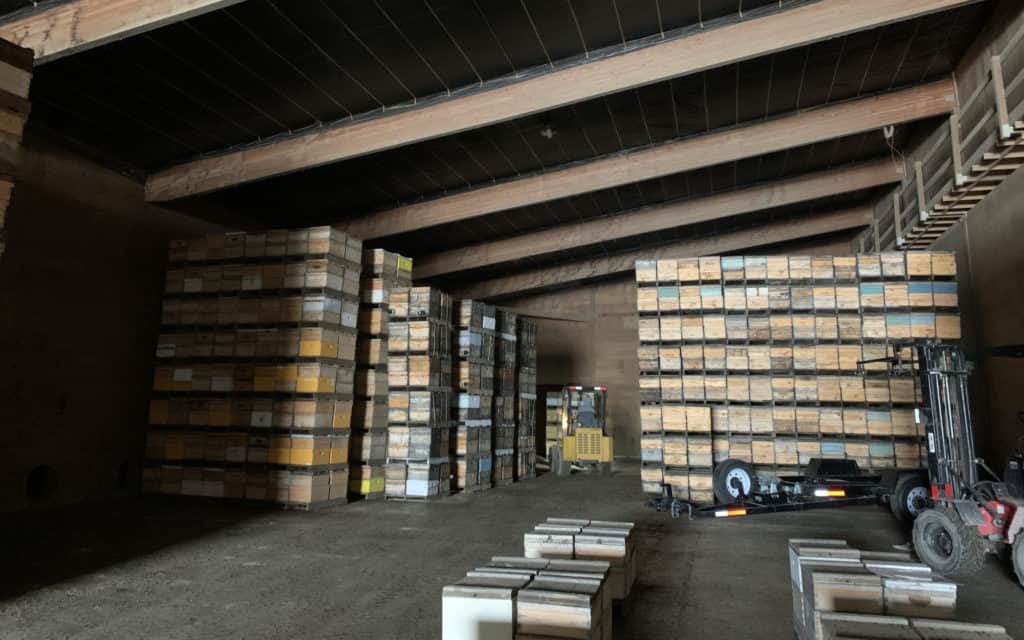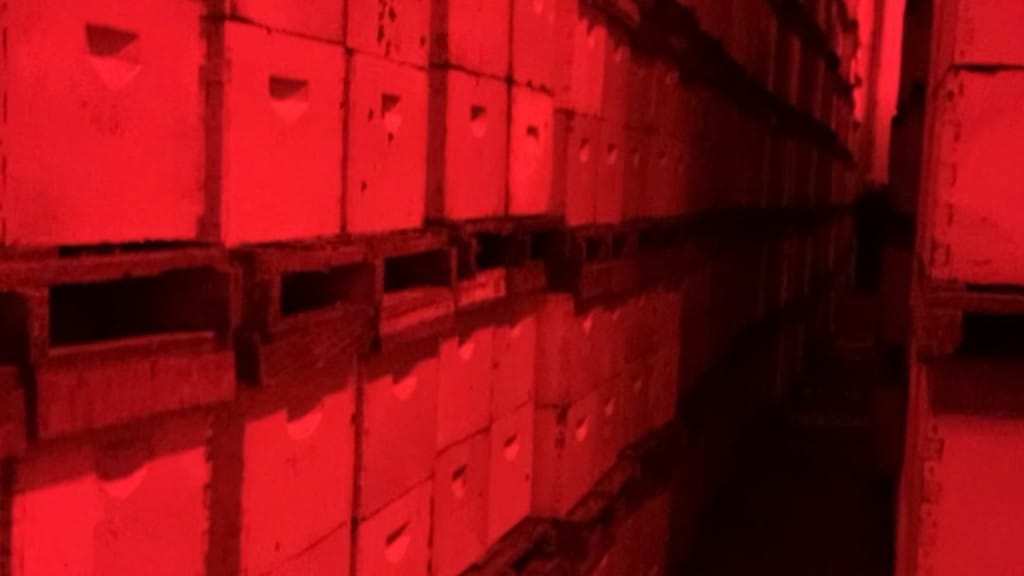In the dim, red glow of the immense warehouse’s lights, tall stacks of wooden boxes are lined up in seemingly endless rows, where they will stand for the next couple of months until spring returns to California. But this is not just a warehouse full of surplus beekeeping equipment, it is an indoor storage facility – and the boxes aren’t empty, but filled with live, honey bee colonies, waiting out the winter weather in this chilly, climate-controlled facility.
Storing bees indoors over the winter months is not new in North America; for many years, some beekeepers in Canada and the northern US have kept colonies inside over the winter to reduce their prolonged exposure to harsh environmental conditions in a wide variety of structures, from cellars, to converted potato and onion sheds, to buildings designed and built specifically for honey bee storage, equipped with the latest climate control and air exchange systems to maintain optimal temperature, humidity, carbon dioxide concentrations and air exchange conditions. Over the last several years, indoor storage has been rapidly gaining greater popularity among US commercial beekeepers and an increasing number of colonies are spending time indoors. This recent increase in interest to temporarily house honey bees indoors is born not only out of the desire to reduce winter losses by providing protection from winter weather, but also because of additional benefits to honey bee health and the bottom line that the timely use of indoor storage may offer some commercial beekeeping operations.
To avoid harsh winter conditions, US commercial beekeepers often move colonies to holding yards in California or other states where the weather is much milder. However, colonies wintering in warmer environments will continue to remain active, rearing brood, and consuming greater resources than they would at cooler temperatures. This results in costs incurred for the labor, travel and supplies needed to feed and manage these colonies during this period that would otherwise be unnecessary when wintering colonies indoors.

Holding yards can also have extremely high colony densities, with hundreds of colonies (or more), often from multiple beekeeping operations, kept in close contact until they can be moved into almond orchards. This can result in enhanced bee drift, which increases the transmission risk of harmful pests and diseases among neighboring colonies, compared to indoor storage facilities that are kept sufficiently cool and dark so that the bees remain within their hives and do not fly.
It is possible to successfully overwinter strong, healthy colonies outside in cold climates, provided they have been adequately insulated and provisioned, therefore avoiding the problems associated with moving colonies to warmer temperatures. But because they are subjected to external environmental conditions, bees will still break cluster and fly on nice days if it is warm enough. This can reduce colony size over time since a portion of the bees who leave the colonies will not return and will not be replaced until the queen begins laying again the following spring. This leaves fewer bees inside the hive to help regulate internal colony conditions. Since bees will also consume greater resources when the weather warms, periodic temperature spikes can increase the risk of starvation for colonies wintered outdoors if colonies do not have sufficient reserves.

Colonies kept in the cool, dark environment of indoor storage facilities will stop producing brood until returned to warmer, brighter conditions. This creates the opportunity for beekeepers to perform any management actions that are best accomplished under broodless conditions just as colonies are brought out of storage. This includes treating for Varroa, the ectoparasitic mite that feeds on developing and adult bees and transmits several harmful honey bee viruses. Varroa can only reproduce inside the capped cells containing developing honey bee brood. Therefore, when colonies stored indoors experience a broodless period, or “brood break”, Varroa are also no longer able to reproduce for the duration of time that the colonies remain broodless.
Brood breaks do not affect the adult Varroa population that already exists within the colonies, but the lack of capped brood cells, where as many as 80% of a colony’s Varroa population regularly resides, creates conditions that make Varroa chemical control treatments much more effective than when applied while brood is present. And because the colonies are all in a single location, Varroa treatment application, and any other management actions taken can be accomplished quickly and efficiently. Although this approach may not be fitting for all operations, some beekeepers are now using indoor storage facilities to induce periodic brood breaks outside of wintertime as part of a comprehensive Varroa management plan.
While there are benefits to keeping colonies in cold storage, there are also a number of costs that may make it impractical for some beekeeping operations to use indoor facilities. This includes the initial cost to build a new structure or retrofit an existing building to make it appropriate for bee storage, as well as the cost of the land on which it is built, and the energy required to run it. Though it may not be possible for a beekeeper to build their own facility, some larger operations will rent excess storage space to other beekeepers, making it a realistic management option for smaller-scale beekeeping operations.
Successfully storing colonies indoors for weeks to months at a time also requires a significant amount of planning throughout the rest of the year to ensure that they have been adequately prepared. Unlike colonies kept outdoors, bees that go into storage are intended to remain undisturbed for the duration of their stay. This means that all management actions, such as feeding, culling or combining weak colonies and treating for Varroa and other diseases must be completed before going into storage, so that beekeepers are only paying to store strong, healthy, disease-free colonies. As beekeepers like to say, “indoor storage is a hotel not a hospital” – the condition of the colonies going into storage will dictate their condition when they emerge.

Given the potential benefits that indoor storage may offer to some commercial beekeeping operations, it is not surprising that there has been a recent rise in beekeeper interest in using them. However, additional research is needed to investigate the benefits and disadvantages of indoor storage for colony health and survival rates and to explore ways in which the benefits of indoor storage may be extended beyond its current benefits. Dr. Brandon Hopkins, Assistant Research Professor and Apiary Manager at Washington State University and Dr. Kelly Kulhanek, Postdoctoral Research Associate in the Hopkins Lab, have been a critical part of the research community effort to further study the application for indoor storage in commercial beekeeping operations, and have been integral in developing an indoor storage guide specific for US commercial beekeepers, which is now available at no cost on the Project Apis m. website (https://www.projectapism.org/indoor-storage-of-honey-bees.html). The Bee Informed Partnership’s Technical Transfer Team has also been working with the Hopkins lab, providing field support for their ongoing research with indoor storage, and will continue to do so in the upcoming field seasons.
Building cold storage facilities in California would be welcomed by beekeepers and almond growers for the benefits that would come with keeping bees in close proximity to almond orchards in the lead up to pollination. Unfortunately, California’s extremely high property and energy costs, combined with the higher energy demands required to keep indoor storage facilities cool when located in warmer climates such as that found in the California Central Valley’s almond growing region, currently make it much more financially attractive to build and maintain facilities outside the state.
The greater number of warm, late autumn days and freeze-thaw cycles during the winter months that colonies wintered in the northern US are now experiencing makes the prospect of storing bees in facilities with controlled, consistent climate conditions more appealing than having to deal with the challenges created by increasingly unpredictable outdoor winter conditions. And whether bees are wintering in Idaho storage sheds or catching a late-spring brood break in a facility further south, it is clear spending more time indoors is what’s in store for many US honey bee colonies.
